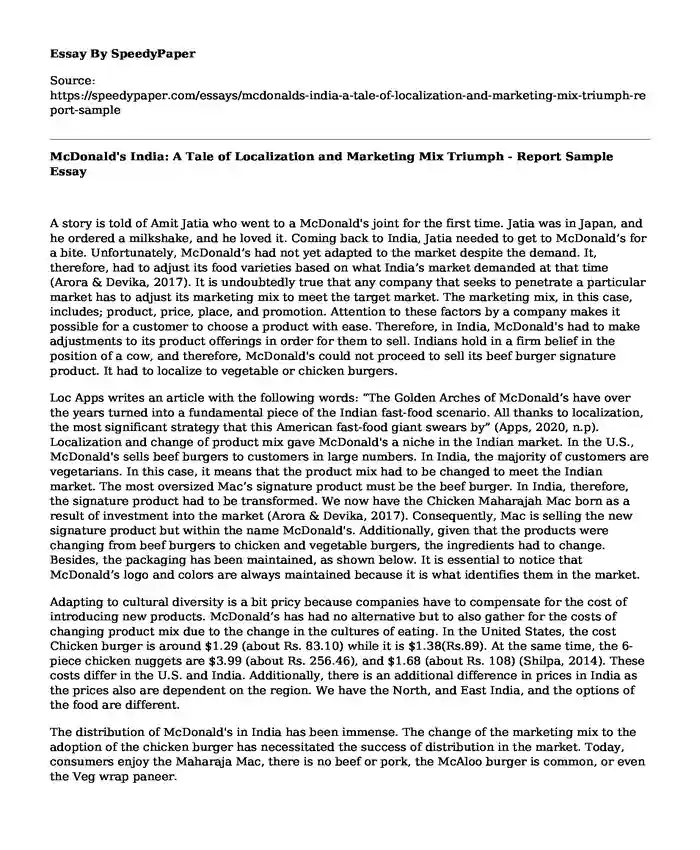A story is told of Amit Jatia who went to a McDonald's joint for the first time. Jatia was in Japan, and he ordered a milkshake, and he loved it. Coming back to India, Jatia needed to get to McDonald’s for a bite. Unfortunately, McDonald’s had not yet adapted to the market despite the demand. It, therefore, had to adjust its food varieties based on what India’s market demanded at that time (Arora & Devika, 2017). It is undoubtedly true that any company that seeks to penetrate a particular market has to adjust its marketing mix to meet the target market. The marketing mix, in this case, includes; product, price, place, and promotion. Attention to these factors by a company makes it possible for a customer to choose a product with ease. Therefore, in India, McDonald's had to make adjustments to its product offerings in order for them to sell. Indians hold in a firm belief in the position of a cow, and therefore, McDonald's could not proceed to sell its beef burger signature product. It had to localize to vegetable or chicken burgers.
Loc Apps writes an article with the following words: “The Golden Arches of McDonald’s have over the years turned into a fundamental piece of the Indian fast-food scenario. All thanks to localization, the most significant strategy that this American fast-food giant swears by” (Apps, 2020, n.p). Localization and change of product mix gave McDonald's a niche in the Indian market. In the U.S., McDonald's sells beef burgers to customers in large numbers. In India, the majority of customers are vegetarians. In this case, it means that the product mix had to be changed to meet the Indian market. The most oversized Mac’s signature product must be the beef burger. In India, therefore, the signature product had to be transformed. We now have the Chicken Maharajah Mac born as a result of investment into the market (Arora & Devika, 2017). Consequently, Mac is selling the new signature product but within the name McDonald's. Additionally, given that the products were changing from beef burgers to chicken and vegetable burgers, the ingredients had to change. Besides, the packaging has been maintained, as shown below. It is essential to notice that McDonald’s logo and colors are always maintained because it is what identifies them in the market.
Adapting to cultural diversity is a bit pricy because companies have to compensate for the cost of introducing new products. McDonald’s has had no alternative but to also gather for the costs of changing product mix due to the change in the cultures of eating. In the United States, the cost Chicken burger is around $1.29 (about Rs. 83.10) while it is $1.38(Rs.89). At the same time, the 6-piece chicken nuggets are $3.99 (about Rs. 256.46), and $1.68 (about Rs. 108) (Shilpa, 2014). These costs differ in the U.S. and India. Additionally, there is an additional difference in prices in India as the prices also are dependent on the region. We have the North, and East India, and the options of the food are different.
The distribution of McDonald's in India has been immense. The change of the marketing mix to the adoption of the chicken burger has necessitated the success of distribution in the market. Today, consumers enjoy the Maharaja Mac, there is no beef or pork, the McAloo burger is common, or even the Veg wrap paneer.
The promotion mix aspect includes the integration of personal selling, advertising, personal selling, sales promotion, and direct marketing. The promotion has been very vital in the build-up of the McDonald's brand in the Indian market. Unlike the U.S., India’s marketing messaging has strong consideration for cultural factors and beliefs. In both the U.S. and India, television commercials, print advertising, and outside advertising are common. In India, for instance, happy meal contests, as well as HAPPY MEAL MENU advertising, are very popular.
References
Apps, L. N. (2020, June 27). How McDonald’s Conquered India through Localisation. Medium. https://locnapps14.medium.com/how-mcdonalds-conquered-india-through-localisation-f70cd4ddf60d
Arora, S., & Devika. (2017, October 1). Minnesota Takes the Cake, as Carlo’s Bakery arrives at Mall of America. Spoon University. https://spoonuniversity.com/place/carlo-bakery-has-landed-in-minnesota-here-s-what-to-expect
Shilpa K., (2014, November 19). How McDonald’s conquered India. BBC News. https://www.bbc.com/news/business-30115555
Cite this page
McDonald's India: A Tale of Localization and Marketing Mix Triumph - Report Sample. (2024, Jan 17). Retrieved from https://speedypaper.com/essays/mcdonalds-india-a-tale-of-localization-and-marketing-mix-triumph-report-sample
Request Removal
If you are the original author of this essay and no longer wish to have it published on the SpeedyPaper website, please click below to request its removal:
- Free Essay on the Google Case Study
- Free Essay with Walmart's Vision and Mission Statement Evaluation
- Service Marketing Essay Sample: A Case of Starbucks' Marketing Mix
- Risk Analysis of Nissan Corporation, Free Essay Example
- Maximizing Performance: Achieving Success in an Imperfect World - Essay Sample
- Free Paper Example on What Is Integrated Marketing Communication?
- Free Paper Sample on Organisational Problem Analysis
Popular categories





